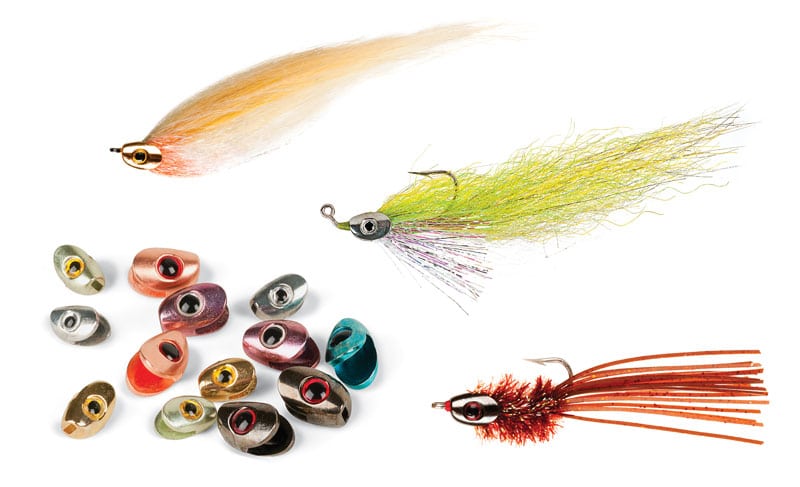
Fish-Skull Fly Heads
Have you ever wondered what makes a Clouser Minnow so effective? More than anything, it’s the dumbbell eyes. The added weight from the eyes allows this world-class pattern to sink quickly into the feeding zone of the fish we pursue. It’s no wonder this pattern has caught more fish in more places around the globe than any other.
As a fly designer, I can tell you without hesitation that almost all of the flies I create have some sort of weight built into them. In my opinion, flies that have a quick sink rate usually outfish weightless patterns. I know that sounds like a bold statement, and there are certainly times when this is not the case. When you’re fishing on or near the surface, or even prowling super-skinny water, where stealth is required, a weightless fly is the way to go. But for almost all other occasions, my flies have some sort of weight — dumbbell eyes, jiggy heads, cones, tungsten nymph weights or lead wire — something that gets the fly down. As effective as these weights are, they sometimes have the tendency to detract from a pattern’s natural contour. For a fly tier, creating a fly that is functional and attractive is where the challenge comes in.
Skull Revolution
Over the past couple of years, Martin Bawden of Flymen Fishing Co. developed a new weight that has revolutionized the flies currently being used in both fresh and salt water. He calls it a Fish-Skull.
Fish-Skulls are available in many colors and sizes (from No. 8 to 4/0) to allow tiers to create just the right fly for the situation. What makes this weight so unique is that it allows fly-anglers to tie the fly first and then add the weight. This is a major advantage for several reasons. It allows the tier to make sure he is satisfied with the design of the fly before adding weight to it. For novice and even intermediate tiers, this means less waste. No more having to cut an undesirable fly apart to salvage the expensive tungsten weight or high-end dumbbell eyes.
When adding a cone head to streamer patterns, tiers must build up a base of thread to make the transition from the final material to the weighted head look smooth. No need to worry about that final transition any more. Just whip-finish the fly and then slide the Fish-Skull through the hook eye and onto the head of the fly. A few wraps of monofilament thread will lock everything neatly into place. An added bonus is that your fly’s finishing thread wraps will be protected by the skull, increasing the durability of your pattern.
Also, Fish-Skulls are designed with a recessed area for the 3-D eyes that come with every package. This recessed area helps prevent the eyes from coming loose after the fly bounces off a rock or dock piling. All you need is a dab of CA glue, and the eyes are locked in place forever.
New Twist on Old Favorites
Another advantage of using Fish-Skulls is that your fly can ride hook up (Clouser-style) or down (Deceiver-style), depending on how the weight is attached.
Fish-Skulls allow you to take already proven patterns and simply make them more effective. Take a Lefty’s Deceiver and add a Fish-Skull to it, and you now have a dynamite-looking Half & Half. Fix the head so you can fish the fly hook-down in deep water, or tie in the head so you can fish it in shallow water with the hook riding up. Try twisting up a Bonito Bunny and placing a Fish-Skull on it, and you will have a fly that not only catches lots of fish but also is indestructible!
Fish-Skull heads were designed to have a keeling effect on flies. Patterns will ride straight and true every time you cast. While you might think that weight placed forward on a fly pattern would give a nose-down sink, this is simply not true. The addition of a Fish-Skull allows flies to sink evenly (horizontally) rather than nose-first, which gives them a more realistic-looking wounded baitfish impression.
Each Fish-Skull has both a top and bottom slot built in. This unique feature makes it possible for tiers to design more lifelike broad-profile baitfish, like bunker and pilchard, which other weights do not allow.
Skull Versatility
Fish-Skulls can accommodate just about any hook found on the market. However, if you would like to view a recommended-hook chart, you can go to the website, www.flymenfishingcompany.org, and get the specifics on which hook size matches which Fish-Skull.
On the West Coast, tiers have already started using Fish-Skulls on 60-degree-bend jig hooks made popular by George Glazener and fly-fishing legend Dan Blanton. West Coast tier Charlie Bisharat told me the Gamakatsu 60-degree flat-eye round-bend hook will fit a Fish-Skull perfectly due to its hook eye being perpendicular (rather than parallel) to the shank. Fish-Skulls are being used nationwide for many types of saltwater species. Bawden said Fish-Skull patterns have already accounted for many different species, including striped bass, false albacore, tarpon, redfish, surfperch, barracuda, bonefish and speckled trout. The next time you are at the bench tying up a few of your favorite can’t-miss patterns, try adding a Fish-Skull to the front of your design. You might find it is just what you have been “weighting” for!









